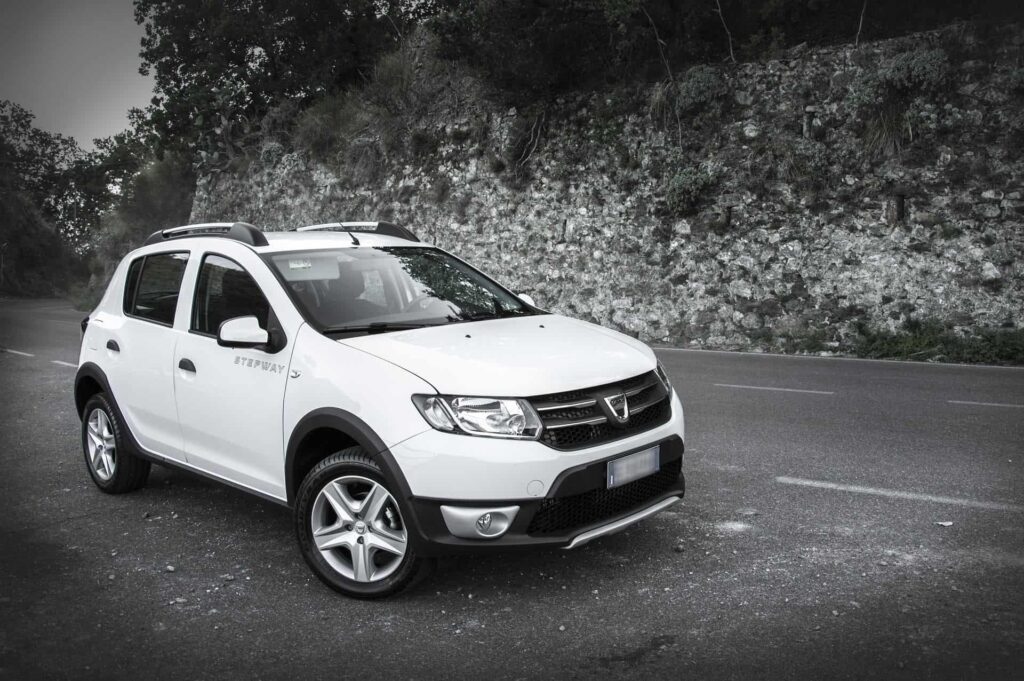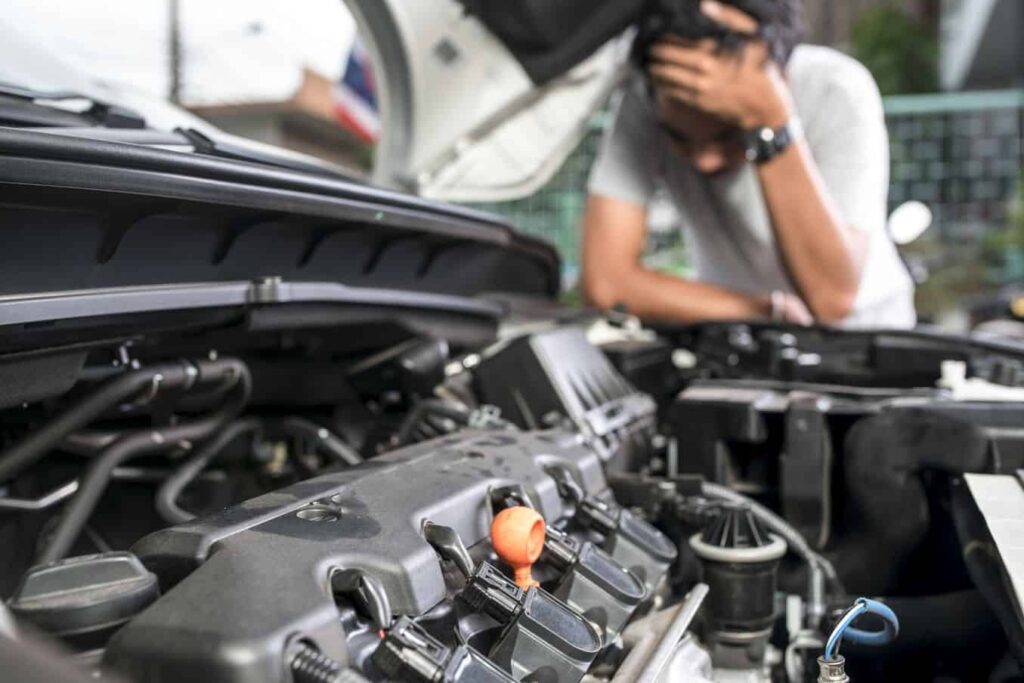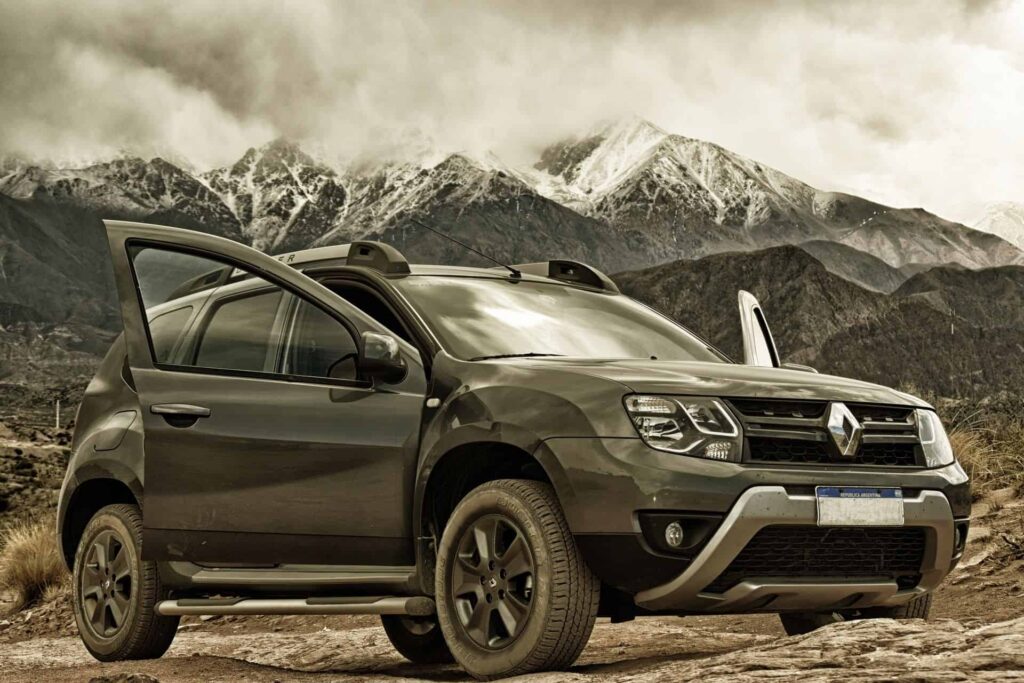8 January 2020 Concept Car
If you’re looking for a used Dacia Duster, you’ve come to the right place. At Concept Car Credit, we’ve loved this quirky little SUV right from the first time it hit UK roads in 2012. And so, you can almost be certain to find at least one of them whenever you visit our Manchester showroom.
Admittedly, the Dacia Duster does not have a great second hand reputation. Don’t let this scare you off. There are very good reasons why most drivers prefer to buy a new rather than a used Dacia Duster. We’ll cover them all in this article.
The secret of its success. The most important competition from other cars. Its many benefits as well as its weak spots. Its bad safety reputation and whether or not rust really is an issue with this car. We’ll also show you how to make the most of your used Dacia Duster.
Now, without further ado, let’s dive in. After all, the story of the Duster reads almost like a fairytale. And it deserves to be told.
In this special, we’ll treat you to an overview of the concept behind Dacia as a brand and the Duster as their most important model. If this doesn’t interest you, just use our quick navigation below to jump straight to the second part of this article: A review of whether or not a used Dacia Duster is a good deal.

During the time of the cold war, very few people in the West paid any attention to Dacia. Even among the notoriously uncool gang of Eastern European car brands, Dacia was by far the most uncool member.
Škodas, typically the cheapest cars on any market, had their fans. Ladas had next to no charisma, but a certain no-thrills understatement.
Dacias, meanwhile, were mostly known for being disappointments in almost every single department. Their quality control left a lot to be desired. Unless you were a member of the Romanian consulate or desperately wanted to impress your new Romanian girl- or boyfriend, there was very little incentive to buy a Dacia.
Things changed in 1999, when French car maker Renault acquired Dacia. Take-overs similar to this one had happened before and not without success: Volkswagen had earlier turned Spanish automobile make Seat from an ugly duckling into a cornerstone of their brand.
Here, however, the situation was anything but clear: Could Renault, itself in a difficult position, really turn Dacia around?
It could. One of the reasons why you can today buy a used Dacia Duster without worrying about it falling apart, is that Renault began improving itself first. For decades, the French manufacturer had enjoyed a less than stellar reputation: Less innovative than Citroën, less reliable than Peugeot, it always seemed slightly under-defined in terms of its image.
This changed with the advent of a new generation of Renaults. The Clio, Megane, the Scenic and of course the gorgeous Captur were eye-catching and instantly recognisable, powerful and, most of all, reasonably reliable. Suddenly, you found your heart beating faster when you spotted one of them on the road.
For Dacia, Renault had a very simple strategy. Whereas Volkswagen essentially tried to make the link with Škoda and Seat invisible, Renault turned Dacia into an addition of its own palette. In some countries, Dacias are actually sold as Renaults!
This gave Dacia a much needed boost in terms of its profile. Dacia reached a 3% market share in 2018. Its growth rates have consistently been in the double digit range.
It also allowed Renault to make its entire production process even more efficient and profitable.
The key to the Dacia strategy can be summed up with just four words: Old parts, new design.
Essentially, each Dacia is constructed using parts from older Renault models. In terms of quality, this is hardly a deficit. After all, many of these have been tried and tested for many, many years. Their stability is second to none and besides: Not every car needs to reinvent the wheel.
The Independent writes, not without admiration:
“So all around the place you see old Renault Clio or Megane bits: the door handles are those lift-up types, for example, and the controls for the audio are in a little pod just behind the steering wheel. The Renault engines have the same lively feel of their ancestors, and the suspension also recalls the soft compliant ride of old-school French saloons. Indeed, not since the Hyundai Terracan have I driven a car that displays such a fine disdain for potholes and speed humps.”
The design, meanwhile, is entirely its own. Compared to the futuristic look of the latest Renaults, the Dacias look more down to earth, slightly cheeky and sympathetic. Plus, they have an almost universal appeal, across genders, age bands and social groups.
One could even argue that very few brands in the industry pay more attention to great design than Dacia. The reason is simple: Once you step inside, there is very little to see and love about these extremely spartan cars! This makes the outward appearance even more important.

The real genius of the new and improved Dacias is Renault’s cost cutting approach. Entitled ‘design to cost’, it effectively reverses the usual production logic. Usually, manufacturers will design a car and then try to keep costs down. With Dacia, the projected sales price is given. And the job of everyone involved is to meet that target. This rule applies to every single part, all throughout the process.
This strategy has allowed Dacia to build a car that’s consistently been the cheapest deal in its class. As the French acknowledge without shame, it has been the main driver behind 2 million sold Dusters since 2010.
Vincent Fournier, program manager for the Duster, explains the concept using an example:
“The first design for the Duster’s roof bar was not easy to manufacture, because the curve of the part went in two directions. The first quotation from the supplier was twice the target. The designer himself went to the supplier’s plant to understand the manufacturing constraints.”
Swiftly, the design was revised to meet the target price.
In practise, ‘design to cost’ has a logical conclusion: The basic version of any Dacia Duster needs to be stripped down to the bone. And, as expected, it really does come almost without any extras whatsoever.
This is the bare minimum you’d expect from a car and you can take that quite literally. You may come to accept that there’s no radio and that you’ll have to manually wind down the windows. But no touchscreen in a 2018 car? That’s certainly something you’ll have to get used to.
Dacia calls this basic version of the Duster Access. Thanks to the minimalist approach of the Access, the company has managed to keep the car below the magic border of 10,000 for a long time. For an SUV, that’s a truly remarkable price.
The next stage is called Essential. This is the version that converts many to the Duster philosophy. The Essential is still extremely affordable, but it offers at least a few extras considered standard in a car these days. You’ll get a radio, better headlights and a roof railing, for example.
The Dacia Duster Comfort adds cruise control, a rear camera and a touchscreen to the equation.
Recently, Dacia added a fourth option to their selection. Called Prestige, it feels almost like any regular car. At 15,000, it also raises the basic price of the cheapest Duster by 50%, just by adding a few accessories.
Speaking about ‘any regular car’ – let’s take a took a look at alternatives to a new or used Dacia Duster. After all, as alluring as the Duster may appear, you’ll definitely want to hatch your options.
Curiously, as many commentators agree, there is actually very little serious competition at all! The current Access version of the Duster is so cheap that even the far smaller Ford Fiesta will set you back £4,000 more ….
Things get even more expensive once you put the Duster side by side with other SUVs. The Seat Ateca costs over £21,000. The Nissan Qashqai currently stands at just under £20,000. So you could go as high as a Dacia Duster Prestige and still save £5,000 on its main rivals!
Which curiously makes Dacia’s very own Sandero Stepway the closest thing to a real alternative the Duster may currently have.

The Sandero is Dacia’s super mini. At an entry price of a mere £7,000, it is also the make’s smallest, cheapest and most important model.
The Duster has received warm reviews. The Sandero, meanwhile, has fared even better, receiving praise all across the board. This may be because the Sandero is a lot lighter than the Duster. Both models ultimately suffer from the somewhat weak Dacia motors. With the Sandero, however, this is simply less of a problem.
The Stepway is Dacia’s attempt at creating a bridge between the Sandero and the Duster. The idea behind it is to create a fusion between an SUV and a super mini. Renault itself successfully achieved this seemingly impossible goal with its remarkable Captur.
Compared to the Captur, the Sandero Stepway seems like an incredible proposition: it’s almost exactly half as expensive as its bigger French sister. However, the Stepway is only slightly cheaper than the Access version of the Duster. Does that make sense?
Ever since it was first released in Romania in 2012, the Stepway has split the public down the middle. There seems to be a consensus that, due to its improved driving characteristics, the Stepway offers better value for money than the hatchback Sandero.
On the other hand, unlike the Duster, the Stepway is not really an SUV in the traditional meaning of the word. It is more or less little more than a Sandero with a raised cabin. That’s certainly not nothing, as we’ve pointed out in our big special on the history of the SUV. But you can definitely not expect to take this car on a challenging off road journey.
The irish Times was particularly critical of the entire concept – or lack thereof:
“What I have a problem with is the fact that the Stepway costs so much relative to the standard fare. The cheapest Stepway you can buy costs €12,290, which makes it €2,300 more than the cheapest Sandero hatchback. It’s a full €1,100 more than the Sandero with the same engine, the 900cc turbo triple petrol. Our test car, fitted with the 1.5 dCi diesel engine, clocked in at a whopping €15,690. For just €300 more you could have the vastly bigger Dacia Duster, which is an actual SUV. Compared to the regular celestial body of the Sandero, the Stepway’s price is bulkier even than that of NML Cygn.”
It does appear as though the Duster truly does not have a serious rival in its price class.
All of this obviously is not to say that the Duster is without its problems. Let’s take a look at the criticism levelled against it by car reviewers.
Perhaps the most excusable point has been the general contention that the Duster is a rather boring and uninspiring vehicle. Especially the Access has come under fire for looking almost empty on the inside.
Clearly, at this price point, it is hard to find fault in this. In fact, it is quite refreshing to find a car where not every single action is performed by electronics. At least partially, the minimalist design marks a return to the actual roots of the SUV as a true allrounder. Certainly, the early iterations of the Ranger Rover did not feel particularly cosy and luxurious from the inside either.
Despite these considerations, Dacia did considerably re-design the interior of the car for the current generation. As Honest John finds, “this is still a budget car, make no mistake, but it’s a lot nicer inside now with less rough plastics and a better quality finish.”

What can be said about the Dacia, however, is that it’s hardly the most powerful car in the world.
According to Topgear, “it’s the deficit of mid-range torque that’s most telling. This is one of the few cars where, if you flatten the throttle at 3,000rpm on a motorway, absolutely nothing happens. Drop a couple of gears and main-road overtaking is possible, but really requires something approaching a five-year plan.”
Of course, they’re exaggerating quite a bit. But their point is clear: In some respects, the engines of the Duster may be just be a tad too weak for the weight of the car of between 2,557–2,853 lb.
Whatcar agrees: “The naturally aspirated petrol unit is truly gutless. Off the mark it’s a real struggle to get it up to speed, with only a slight whiff of enthusiasm to its acceleration at 5000rpm, although this disappears again almost as soon as it has arrived. Around town it isn’t such an issue, but if you choose it, be prepared to work this engine very hard most of the time.”
At the same time, don’t let these harsh words fool you. For most drivers, the Duster will work just fine.
A final point of contention is the alleged lack of safety features of the Duster.
It is certainly true that the Duster is a bit on the light side here. It offers very little in the sense of contemporary active safety applications. Blindspot monitoring is only included in the Prestige series. Automatic emergency braking is not even offered as a paid add-on.
As a result, the Duster currently only holds a puny three star rating in the Euro NCAP crash tests.
Safety always comes first. So these results are surely disappointing. However, there are other ways of looking at this. A three star rating is still anything but disastrous and the Duster does come with six airbags.
Moreover many of these safety features have only been developed very recently. The car you’re currently driving most likely won’t have them. Even much more expensive cars have only added them a short while ago. Would you therefore consider them a risk to drive?
Without a single doubt, Dacia will add these features as soon as they can be integrated into its bigger price policy. For the moment, however, the Dacia is still a fairly safe car to drive – albeit not the safest by any means.
There is one final point of criticism we need to talk about. This is particularly critical when it comes to buying a used Dacia Duster: There have been claims that the Duster is susceptible to rust.
The rust issue is not a rumour. There have definitely been several reported cases where Dacias produced for the UK market developed rust early on in their life cycle. Should you therefore avoid buying a Duster?
Hardly. Dusters with rust were rare for starters. Secondly, Dacia dealt with the issue quickly. It was found that the problems only affected cars produced in the company’s Indian production facility. Faulty paint application was found to be the cause of the rust. Dacia followed up on this by moving production back to Romania. Since then, the issue has not appeared on following Dacia generations.
Customers affected by the rust issue were offered to have their Duster patched up. Still, if you intend to buy a used Dacia Duster, it does make sense to verify you’re getting a ‘Romanian Dacia’.
Now we’ve dealt with some of the issues of the Duster, let’s turn towards the fun stuff: All the things that make this car so popular and great!
We’ve touched on some of the engine troubles before. Let is be said, however, that driving a Duster is not a grievous affair by any means. Quite on the contrary. The ride has been described as fluent and smooth, as long as you keep the motor within its limits.
The suspension of the Duster has been the subject of particular praise. A child of the famous French suspension school, it has been described as offering the finesse of a large saloon. As the clearly enamoured journalist of newspaper The Independent put it: “Not since the Hyundai Terracan have I driven a car that displays such a fine disdain for potholes and speed humps.”

In fact, the Duster is at its best when you stick to the city. This may seem to defy its stated purpose as an SUV. Some have even called this type of vehicle a ‘faux by four’, indicating that the offroad capabilities are rather theoretical in nature.
There are two things to consider here, however. For one, the Duster is perfectly capable of handling rougher terrain. Some have even put it to the ultimate test and undertaken expansive expeditions with it. Although by no means perfect and no match for a true jeep, it has definitely stood its ground in these tests.
Secondly, the modern SUV has long turned into a different creature than its more rugged earlier incarnations. The main benefits of an SUV are its elevated seating position, its ample space and its family friendly flexibility. From this angle, the Duster will do just fine for 99% of current drivers in the UK.
As we’ve stated before, the Ceaușescu-era Dacias were not exactly famous for their excellence. Over the last years, however, Renault has relentlessly improved the build of the Sandero, Duster and Logan to the point where they are actually among the most reliable cars in their respective categories.
In the AutoExpress Driver Power survey, Dacia ended up in third spot with a n impressive score of 96.17/100. This put it higher up the ladder than the supposed kings of reliability, Toyota and Honda. Subsequent tests have proven that this was by no means a fluke: The Duster consistently scores high on reliability contests.
It is actually not that hard to understand why this is so. Thanks to its simple, down to earth construction, and its reduced amount of electrical wiring, there is very little that can break down in a Dacia. Combine this with a powerful quality assurance policy and you get a car that is both cheap and indestructible.
All of this makes the Duster sound like the perfect car for inner city families. Curiously, some of the reasons why it’s such a great proposition new mean that it’s quite hard to find a suitable used Dacia Duster.
What do we mean by that?
Simply, the Duster hardly depreciates. At all. It is one of the best models out there at the moment at retaining its value. In WhatCar’s list of the slowest depreciation cars in 2017, the Duster was fourth overall, depreciating just 15% in the first year and just over 40% at the three year mark. Only luxury cars like the Lotus Elise, the Audi S3 and the Land Rover Discovery scored better.
The result seems counter intuitive at first. On closer inspection, however, it makes perfect sense. Over the first years after its introduction, depreciation was decent at best. It certainly didn’t hurt anyone. Because a new Duster was so cheap anyway, the loss in absolute terms was very much negligible.
As time went on, the Duster’s reputation greatly improved. Today, they hold their value well in both absolute and relative terms.
Here are some of the reasons:

Buying a used Dacia Duster nonetheless makes perfect sense, if you wait for the best moment. This appears to be at the three year mark. While the Duster has a great depreciation at year one and two, it takes a bit of a nose dive after 48 months. As a buyer, this offers you a great opportunity to benefit from this price reduction.
Right now may well be the best time to buy a used Dacia Duster. This is because Dacia only recently overhauled the model, improving on some of its most widely criticised points. This includes a major re-working of the interior: The driver’s seat is no longer wobbly, the design and feel of the dashboard has improved and so has sound insulation.
On the outside, not a lot has changed. Still, the new Dacia does look a bit more edgy and rough, which adds to its raw charm.
Thanks to the new version of the Dacia, second hand models should now become a lot more attractive. So it’s about time to head over to our showroom to find a Duster to suit your budget and needs.
Rust is obviously the first thing you should check. This only affects a small batch of vehicles built before 2014. But you should still make sure yours isn’t one of them. As Carbuyer states: “Look for any signs of corrosion, lifting up the boot carpet and closely inspecting all areas for rot.”
AutoExpress have compiled a few more weak spots in a feature dealing with buying a used Dacia Duster:
All in all, there are many reasons why the Duster has quickly built up an army of fans. It is an excellent drive in the city and offers more than reasonable offroad capacities. Its weaknesses are its engine power and not quite up to speed safety features. But it more than makes up for this with its unmatchable price, incredible reliability, spacious interior and excellent depreciation.
At our showroom, you can usually find at least one or two used Dacia Dusters. Do take a look online or on our Facebook account for updates on a day to day basis. Or drop by our Manchester showroom – we’re here to help!
8 January 2020 Concept Car